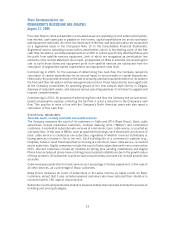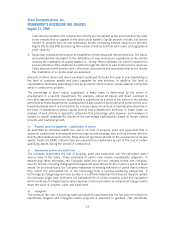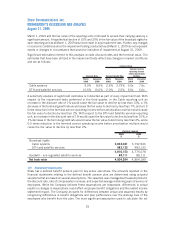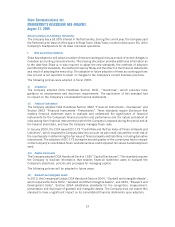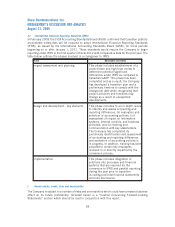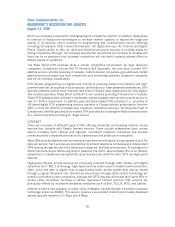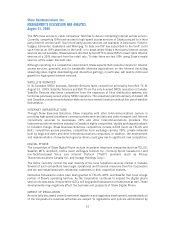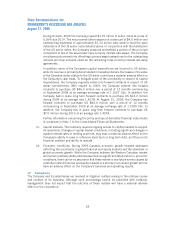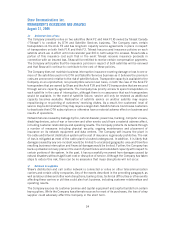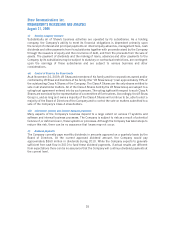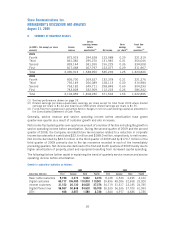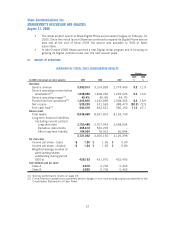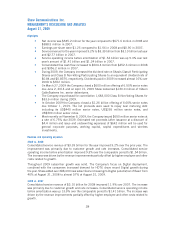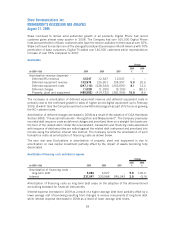Shaw 2009 Annual Report Download - page 33
Download and view the complete annual report
Please find page 33 of the 2009 Shaw annual report below. You can navigate through the pages in the report by either clicking on the pages listed below, or by using the keyword search tool below to find specific information within the annual report.The risks and uncertainties discussed below highlight the more important and relevant factors that
could significantly affect the Company’s operations. They do not represent an exhaustive list of all
potential issues that could affect the financial results of the Company. The principal risks include:
kCompetition and technological change, including change in regulatory risks
kInterest rate, foreign exchange, capital market and economic conditions risks
kContingencies
kUninsured risks of loss
kReliance on suppliers
kHolding Company structure
kControl of Shaw by the Shaw family
kInformation systems and internal business processes
kDividend payments
i) Competition and technological change
Cable and satellite providers operate in an open and competitive marketplace. Shaw’s businesses
currently face competition from regulated entities utilizing existing or new communications
technologies and from currently unregulated internet and illegal satellite services. In addition,
Shaw may face competition in the future from other technologies being developed or to be
developed.
CABLE TELEVISION AND DTH
Shaw’s cable television systems currently compete or may in the future compete with other
distributors of video and audio signals, including DTH satellite services, satellite master antenna
systems, multipoint distribution systems (“MDS”), other competitive cable television undertakings
and telephone companies offering video service. To a lesser extent, Shaw’s cable television systems
compete with the direct reception by antenna of unencrypted over-the-air local and regional
broadcast television signals. As noted above, Shaw also competes with unregulated internet
services, and illegal satellite services including grey and black market and modified free-to-air
satellite receivers.
MDS delivers television programming by unobstructed line-of-sight microwave transmission to
subscribers equipped with special antennae. Since 1995, the CRTC has approved MDS
applications of distributors competing with cable television service in given service areas. In
particular, the CRTC has granted licenses to Craig Wireless International Inc. (formerly Skycable
Inc.) with respect to certain areas of Manitoba and British Columbia, and to Image Wireless
Communications Inc. with respect to certain areas of Alberta and Saskatchewan.
Other competitive cable television undertakings are licensed to operate within the authorized
service areas of incumbent cable licensees. Novus Entertainment Inc., one of these licensed
providers, operates within one of Shaw’s licensed service areas in Vancouver.
Canadian telephone companies are also licensed as BDUs to provide standard and interactive
television services. TELUS currently offers Telus TV in select parts of Alberta and British Columbia;
SaskTel offers Max TV in Saskatchewan; MTS offers viewers a competitive choice with MTS TV,
primarily in Winnipeg, Manitoba, and Bell offers services in parts of Ontario.
Almost all of Shaw’s cable systems are concentrated in major urban markets, having favourable
demographics and growth potential, with most of the remainder in smaller clusters, linked via fibre
optic distribution systems either to each other or to larger markets. Through this clustering strategy,
Shaw maximizes the benefits of operating efficiencies, enabling it to be a low-cost service provider,
29
Shaw Communications Inc.
MANAGEMENT’S DISCUSSION AND ANALYSIS
August 31, 2009


